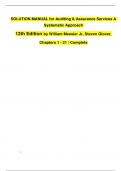Exam (elaborations)
SOLUTION MANUAL for Auditing & Assurance Services A Systematic Approach 12th Edition by William Messier Jr, Steven Glover,
Table of Contents Chapter 1: An Introduction to Assurance and Financial Statement Auditing Chapter 2: The Financial Statement Auditing Environment Chapter 3: Audit Planning, Types of Audit Tests, and Materiality Chapter 4: Risk Assessment Chapter 5: Evidence and Documentation Chapter 6: Inter...
[Show more]



